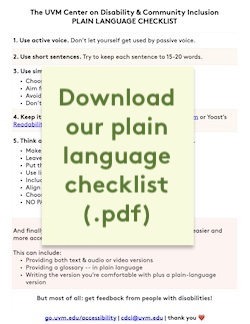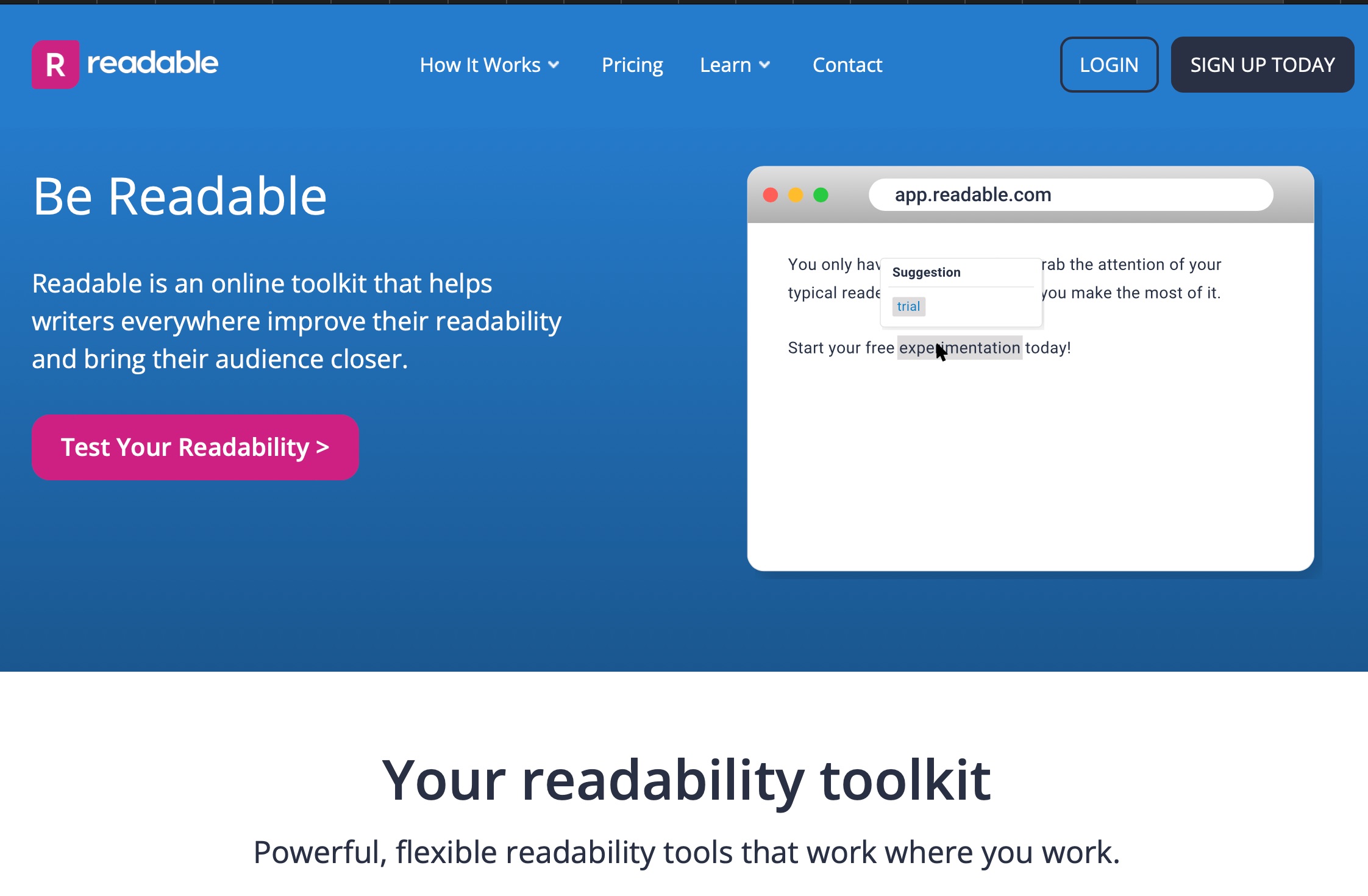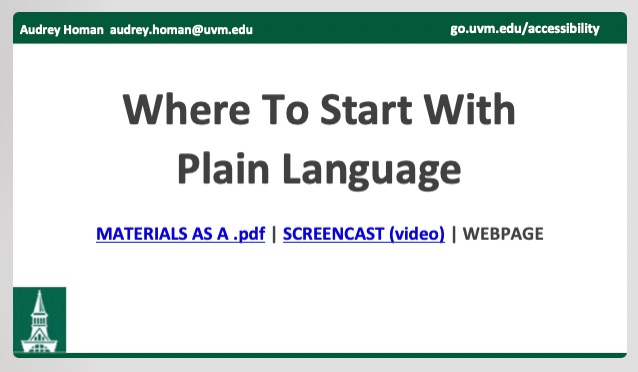Why Plain Language?
Plain Language helps everybody.
Plain language makes reading easier for people with intellectual and developmental disabilities, as well as people who have difficulty reading because of dyslexia or other reading issues.
We're writing for:
- people with permanent disabilities
- people with temporary disabilities, and
- people with situational disabilities.
People with permanent disabilities -- such as intellectual and cognitive disabilities, or dyslexia, and other reading abilities -- benefit from plain language because it takes them less effort to read it. Depending on how severe the disability is, they may only be able to read things in plain language.
People with temporary disabilities -- such as a concussion, or an eye injury -- may appreciate plain language because it makes it easier for them to read things.
And people with situational disabilities -- such as reading on a phone or tablet in bright sunlight, or reading while trying to make dinner at the same time -- might appreciate plain language because it helps them in that situation.
Who else?
Plain language also makes reading easier for people who are learning English, who are translating your work, or who are just really, really busy.
It's easier for people to skim and digest plain language, and will make your work more popular. Ease of reading is also one of the metrics Google uses to assign your work a rank in its search engine.
The 5 Elements of Plain Language
1. Active Voice
We eat the cake.
Active voice is when someone in a sentence does something. Passive voice is the opposite. In passive voice, things happen to someone.
Here's an example:
Active voice:
"We eat the cake."
"We" are the someone, and what we are doing is eating cake.
Passive voice:
"The cake was eaten."
What is happening? The cake is a thing and what's happening to it is that it is getting eaten. But who is doing all that eating? It is a mystery.
Plain Language tries to avoid mysteries.
2. Shorter Sentences
We eat the cake quickly.
Shorter sentences are easier to follow than long ones. Shorter sentences give your brain time to reset between sentences. They make a long passage of text bite-sized.
So instead of a long sentence:
"It's exciting to present these cakes to you as triumphs of the art of baking, the spirit of baking, and the joy of eating cakes of all shapes, flavors, and compositions!"
Use many short sentences:
"It's exciting to present these cakes to you! They are triumphs of the art of baking. They are triumphs of the spirit of baking. And we hope everyone enjoys cakes of all kinds."
A good rule of thumb is to keep your sentences to 15 words or less.
3. Use Simple, Familiar Language
Use Common Words
Words that are simple and familiar take less effort to read than words you don't run into very often. Whenever possible, use common words. For instance, instead of "utilization", choose "use". Or instead of "entrepreneur" use "business owner".
Avoid Jargon
Whenever possible avoid jargon. Stop and think about the words you're using; would someone you met on the street understand those words? Words that are only used by a certain group of people, such as doctors, or lawyers, or scientists, or childcare professionals -- those are jargon. They're harder for people who are not part of that group to understand.
Three Syllables or Less
Words that are shorter take less effort to read than longer words. Whenever possible, use words that are no longer than three syllables. For instance, instead of "wordsmithing", use "rewrite", or "edit".
Acronyms Are Hard to Remember
An acronym is a set of letters where each letter stands for a word in a phrase or name. For instance, "NASA" is an acronym that stands for National Aeronautics and Space Administration. Acronyms take more effort to read because each time you read an acronym, your brain has to connect it with the full name or phrase it stands for. Use acronyms when you need them, but think about whether you could say it another way.
4. Keep it at a 6th Grade Reading Level
Meet Readable.com
A good rule of thumb for Plain Language is to write at a 6th grade level. But how do you know if what you're writing is at or above this level?
You measure it.
If you go to Readable.com, you'll find an online readability calculator. You can paste text paragraphs, or whole documents into the site, and Readable will tell you what grade level the text is. It will also give you suggestions for how to decrease the grade level, such as by shortening sentences, or changing words.
5. Think About Layout
The way you present information can help people understand it. There are ways you can format text to make it easier to understand.
Formatting For Plain Language
- Provide a glossary for any words of more than 3 syllables, as well as your acronyms. The glossary itself should be in plain language.
- Write shorter paragraphs.
- Include more white space on your page, whether it's a web page, or a flyer, or a report.
- Include headings on your page. Headings help people skim large pieces of text. They also help people remember what they've read. Plus people who use screen readers or keyboard-only navigation need them.
And if you're not comfortable making something plain language, offer two versions. Write one the way you're comfortable with it, and also provide a plain language version.
A Plain Language Exercise
Pick one piece of text and make it plain language.
Choose a sample paragraph from the real-world examples below. The examples cover academic writing, a news article, a podcast summary, an accessibility website, and a popular media article.
Read the sample paragraph and think about the 5 Elements of Plain Language. Ask yourself:
- Is it in active voice, or passive voice?
- Could the sentences be shorter?
- Is the vocabulary simple? Does it use common words? Are there a lot of acronyms?
- What does the layout look like?
- Could the average sixth grader understand this paragraph?
Real World Paragraphs
| Piece | Paragraph |
|---|---|
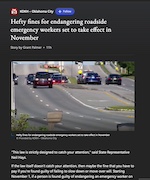 A news story: "Hefty fines for endangering roadside emergency workers to take effect in November" (MSN.com) A news story: "Hefty fines for endangering roadside emergency workers to take effect in November" (MSN.com) | "If the law itself doesn't catch your attention, then maybe the fine that you have to pay if you're found guilty of failing to slow down or move over will. Starting November 1, if a person is found guilty of endangering an emergency worker on the roadways, they can face fines of $1,000 for their first offense. The $1,000 fine is a significant hike from the current fine, which is only $250. The fines only become more costly for repeat offenders, with the fine being $2,500 for the second offense.” |
 An academic book: Turn On, Tune In, Drift Off: Ambient Music's Psychedelic Past, by Victor Szabo An academic book: Turn On, Tune In, Drift Off: Ambient Music's Psychedelic Past, by Victor Szabo | "Ambient music, while appearing in name to be an asocial and suprastylistic artform, was in truth a socially savvy stylization of the intoxicating affective and embodied pleasures of psychedelic drone- and loop-based atmospheric audio for a presumptively white hip and high-middlebrow market." |
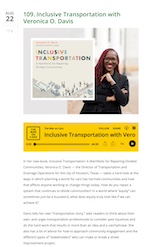 Summary of an episode of the podcast "The War on Cars", featuring transportation planner Veronica O. Davis Summary of an episode of the podcast "The War on Cars", featuring transportation planner Veronica O. Davis | "In her new book, Inclusive Transportation: A Manifesto for Repairing Divided Communities, Veronica O. Davis — the Director of Transportation and Drainage Operations for the city of Houston, Texas — takes a hard look at the ways in which planning a world for cars has harmed communities and how that affects anyone working to change things today. How do you repair a system that continues to divide communities? In a world where “equity” can sometimes just be a buzzword, what does equity truly look like if we can achieve it? |
Bonus exercise: Do you like plain language?
As a bonus activity, think about one piece of media you really like. It could be a podcast, a book, a tv show, or a website.
Then ask yourself:
- Does it use plain language?
- Would you recommend it to a friend who you know has a cognitive disability?
There are no wrong answers in this exercise. But thinking about why we like what we like can be useful in learning to make things more accessible.
The 30-Day Challenge
Take It One Element At A Time
As you get started with plain language, pick one thing you're going to try for the next 30 days. Maybe it's just shorter sentences. Maybe you choose to focus only on active voice. Write yourself a post-it note and stick it on the corner of your monitor as a reminder.
At the end of the 30 days, pick another element of plain language and write another post-it note.
And above all: get feedback from people with disabilities on your work!
Why Plain Language Is Important
Accessibility is a journey. It's a process. And there are a lot of things to remember. But every time you try to move closer to plain language, you're moving ahead with that process. If you're not comfortable using only plain language for a report or web page, spend some time thinking about why that is.
Ask yourself:
- Who are you afraid you're leaving out?
- Who are you leaving out when you don't use plain language? What are you saying about who's welcome in the community you're creating?

